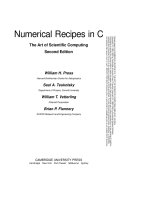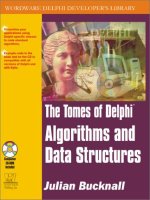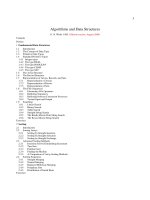Algorithms and Data Structures in C part 1 pdf
Bạn đang xem bản rút gọn của tài liệu. Xem và tải ngay bản đầy đủ của tài liệu tại đây (102.06 KB, 6 trang )
Algorithms and Data Structures in C++
by Alan Parker
CRC Press, CRC Press LLC
ISBN: 0849371716 Pub Date: 08/01/93
Previous
Table of Contents Next
Chapter 1
Data Representations
This chapter introduces the various formats used by computers for the representation of integers,
floating point numbers, and characters. Extensive examples of these representations within the
C++ programming language are provided.
1.1 Integer Representations
The tremendous growth in computers is partly due to the fact that physical devices can be built
inexpensively which distinguish and manipulate two states at very high speeds. Since computers
are devices which primarily act on two states (0 and 1), binary, octal, and hex representations are
commonly used for the representation of computer data. The representation for each of these
bases is shown in Table 1.1.
Table 1.1
Number
Systems
Binary
Octal Hexadecimal Decimal
0 0 0 0
1 1 1 1
10 2 2 2
11 3 3 3
100 4 4 4
101 5 5 5
110 6 6 6
111 7 7 7
1000 10 8 8
1001 11 9 9
1010 12 A 10
1011 13 B 11
1100 14 C 12
1101 15 D 13
1110 16 E 14
1111 17 F 15
10000 20 10 16
Operations in each of these bases is analogous to base 10. In base 10, for example, the decimal
number 743.57 is calculated as
In a more precise form, if a number, X, has n digits in front of the decimal and m digits past the
decimal
Its base 10 value would be
For hexadecimal,
For octal,
In general for base r
When using a theoretical representation to model an entity one can introduce a tremendous
amount of bias into the thought process associated with the implementation of the entity. As an
example, consider Eq. 1.6 which gives the value of a number in base r. In looking at Eq. 1.6, if a
system to perform the calculation of the value is built, the natural approach is to subdivide the
task into two subtasks: a subtask to calculate the integer portion and a subtask to calculate the
fractional portion; however, this bias is introduced by the theoretical model. Consider, for
instance, an equally valid model for the value of a number in base r. The number X is represented
as
where the decimal point appears after the kth element. X then has the value:
Based on this model a different implementation might be chosen. While theoretical models are
nice, they can often lead one astray.
As a first C++ programming example let’s compute the representation of some numbers in
decimal, octal, and hexadecimal for the integer type. A program demonstrating integer
representations in decimal, octal, and hex is shown in Code List 1.1.
Code List 1.1 Integer Example
In this sample program there are a couple of C++ constructs. The #include <iostream.h> includes
the header files which allow the use of cout, a function used for output. The second line of the
program declares an array of integers. Since the list is initialized the size need not be provided.
This declaration is equivalent to
int a[7]; — declaring an array of seven integers 0-6
a[0]=45; — initializing each entry
a[1]=245;
a[2]=567;
a[3]=1014;
a[4]=-45;
a[5]=-1;
a[6]=256;
The void main() declaration declares that the main program will not return a value. The sizeof
operator used in the loop for i returns the size of the array a in bytes. For this case
sizeof(a)=28
sizeof(int)=4
The cout statement in C++ is used to output the data. It is analogous to the printf statement in C
but without some of the overhead. The dec, hex, and oct keywords in the cout statement set the
output to decimal, hexadecimal, and octal respectively. The default for cout is in decimal.
At this point, the output of the program should not be surprising except for the representation of
negative numbers. The computer uses a 2’s complement representation for numbers which is
discussed in Section 1.1.3 on page 7.
Code List 1.2 Program Output of Code List 1.1
Previous Table of Contents Next
Copyright © CRC Press LLC
Algorithms and Data Structures in C++
by Alan Parker
CRC Press, CRC Press LLC
ISBN: 0849371716 Pub Date: 08/01/93
Previous
TableofContents Next
1.1.1UnsignedNotation
Unsigned notation is used to represent nonnegative integers. The unsigned notation does not
support negative numbers or floating point numbers. An n-bit number, A, in unsigned notation is
represented as
with a value of
Negative numbers are not representable in unsigned format. The range of numbers in an n-bit
unsigned notation is
Zero is uniquely represented in unsigned notation. The following types are used in the C++
programming language to indicate unsigned notation:
•unsignedchar(8bits)
•unsignedshort(16bits)
•unsignedint(nativemachinesize)
•unsignedlong(machinedependent)
The number of bits for each type can be compiler dependent.
1.1.2SignedMagnitudeNotation
Signed-magnitude numbers are used to represent positive and negative integers. Signed-
magnitude notation does not support floating-point numbers. An n-bit number, A, in signed-
magnitude notation is represented as
with a value of
A number, A, is negative if and only if a
n - 1
= 1. The range of numbers in an n-bit signed
magnitude notation is
The range is symmetrical and zero is not uniquely represented. Computers do not use signed-
magnitude notation for integers because of the hardware complexity induced by the
representation to support addition.
1.1.32’sComplementNotation
2’s complement notation is used by almost all computers to represent positive and negative
integers. An n-bit number, A, in 2’s complement notation is represented as
with a value of
A number, A, is negative if and only if a
n - 1
= 1. From Eq. 1.16, the negative of A, -A, is given as









